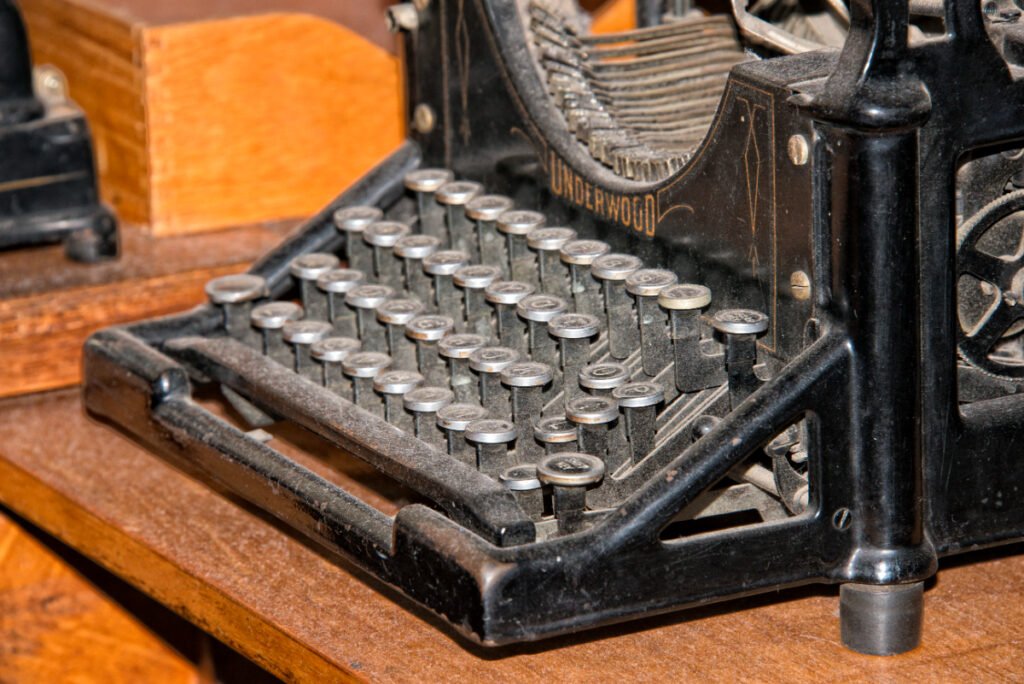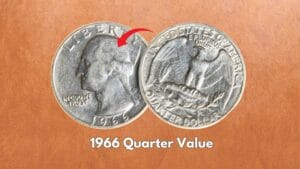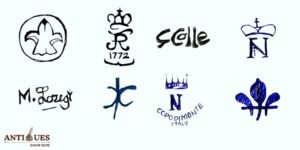Antique typewriters might come across as a small, futile collectible in this world of smartphones. But today, many collectors love them for their unusual key layouts and cases.
In fact, the legendary Forrest Gump actor Tom Hanks couldn’t escape their magic and owns a massive collection of about 250 typewriters, each worth $350 or more! Famous writers like Cormac McCarthy and Danielle Steel also collect aesthetic vintage typewriters!
So, what makes an old typewriter such a huge attraction? Is it their cased keys, inks, or brands? And how do you know its correct value? You’ll get all the answers in this detailed antique typewriter value guide’s details! Let’s start!
Key Takeaways
- Antique typewriters with functional keys, decals, ribbons, and levers fetch up to $3,000 in the antique market.
- Among all the five types of vintage typewriters available in the market, the manual table or portable typewriters fetch the highest value, up to $1,500.
- Branded typewriters like Remington, Royal, or Oliver are worth more because of their original logos and labels.
- Antique typewriters have different fonts, but the ones with Pica, Elite, or Techno scripts sell fast due to their old and mono-spaced letters.
Features of a Valuable Antique Typewriter

If you want to pick a rare and valuable antique typewriter among many old & rusty ones, look for the following features:
- Working keys, ribbons, decals, and rotating levers
- A manual margin lever to set the left and right margins on paper
- Different types of keyboards like ‘QWERTY,’ ‘DVORAK,’ and ‘AZETY’
- Superior Pica, Elite, or Vogue fonts
- 12” carriage for landscape orientation
- Might have unique paper stencils for ‘Serif-style’ letters
- Might have a ‘typewheel’ or ‘typebar’ mechanism to rotate the characters and print them on paper
Who Made the First Typewriters & When?
Well, historians still debate the origins of the first typewriter. Some track it to old Chinese hand printing techniques, while others credit Sir Johannes Gutenberg’s printing press (1450s) for the same!
But the facts state that the English inventor, Henry Mill, made the first patented typewriter in London. But it wasn’t a commercial success since it was heavy and slow!
In the 1830s, makers like Agostino Fantoni, Pellegrino Turri, and Pietro Conti di Cilavegna added different fonts, symbols, and a Braille script for blind people on the keyboard. But these prototypes were never manufactured.
In 1865, Rasmus Malling-Hansen invented the first commercial typewriting machine with uppercase letters and symbols. Then Christopher L. Sholes & Carlos Glidden improved Hansen’s design in 1868 with calibrated type guides, spools, ribbons, and type wheels for precise lettering.
Later, many makers reproduced this design and established their brands. But with the introduction of the first commercial computer with an attached keyboard in the 1900s, people stopped using typewriters, making them collectible today!
5 Types of Vintage Typewriters & Their Estimated Values

Now, let’s analyze how the different antique typewriter types and designs affect its resale cost today:
| Antique Typewriter Types | Top Collectible Features | Year | Estimated Value (Based on Condition) |
| Table Typewriters | A simple printer-like typewriter with paper trays, footrests, manual carriage levers, and typical serif or gothic fonts | 1800s – 1900s | $300 – 2,500 |
| Portable Typewriters | Compact & lightweight typewriters with a special carrying case, reduced keyboard keys (no number keys), and built-in night lamps | Early 1900s | $150 – 1,500 |
| Electric Typewriters | Machine-made typewriters with a mechanized (electric) typing mechanism, automatic carriage lever, and line spacing | 1900s | $40 – 500 |
| Calculator Typewriters | Dual typewriters with a basic QWERTY keyboard and a numeral dial for basic arithmetic problems | 1900s | $70 – 500 |
| Musical Typewriters | Unique typewriters with musical notations pressed ribbons, and pre-printed music rolls | 1900s | $30 – 200 |
6 Important Factors to Identify & Value a Vintage Typewriter
Besides the design and types, other crucial factors like age, brand, and materials greatly impact the final value of your old typewriter. Let’s see how!
1. Antique Typewriter’s Age & Patent Numbers

Old typewriters don’t have any dates or labels. So, how do you verify if your typewriter is old & worth collecting? Simple, just get a magnifying glass and check for the patent numbers on the following spots:
- On the typewriter’s front or back panel
- On the side of the keyboard frames
- On the base or typewheels
- On the carriage levers or platens
But what if your typewriter doesn’t have a patent number? In that case, just compare the era-specific features from the table to learn the years and values:
| Old Typewriter Years | Age | How to Identify Them? | Patent Numbers | Average Value |
| 1870s (First Commercial Typewriters) | 133 – 153 years | Simple, typebar-style typewriters with manually set margins, spacing, carriage returns, and QWERTY keyboards | US171335, US175051, US191617, US199263 | $1,000 – 3,000 |
| 1890s | 123 – 133 years | Continuation of the typebar feature, but with a visible platen, automatic margins, line spacing, and ribbon reverse buttons | US421921, US423576, US423945, US426931 | $900 – 2,000 |
| 1900s | 93 – 123 years | Portable, three-step keyboard typewriters with automatic type wheels, levers, carriage return levers, and feed rollers | US656658, USRE11850, US658931 | $100 – 1,500 |
| 1930s | 53 – 93 years | Uses extra manual controls to control typing speed, indents, and upper-case letters | USD89709, US1865288 | $70 – 1,000 |
| 1970s | 43 – 53 years | Fully electronic typewriters with battery-operated mechanisms, digital screens, and sleek metal cases | US3677386A | $30 – 500 |
Look for small and portable typewriters with a height of 8.5 – 9” for more returns.
2. Vintage Typewriter Materials

One of the easiest ways to appraise an old typewriter’s worth is to check its materials. So, just slide your hand along the frames and feel the texture.
If it feels coarse & bumpy, it might be the 1800s handcrafted iron or brass typewriter. But, if the frames feel smooth and cold, it might be a new steel or glass typewriter worth up to $700.
| Old Typewriter Materials | Identifying Clues | Estimated Cost |
| Cast Iron | Look for 3-4mm frames with a coarse, powdery finish, casting marks, or pitting | $400 – 3,000 |
| Brass | Shiny brown or golden frames with handmade imperfections like bumps, dents, and uneven thickness | $200 – 2,000 |
| Nickel or Steel | Anti-corrosive, silvery-white frames with a rough, brushed or satin-like finish | $90 – 1,200 |
| Cast or Molded Glass | Transparent or translucent frames and keytops with labeled calibrations and etched logos or brand names | $90 – 700 |
| Bakelite & Plastic | Opaque & non-reflective frames with typical mold marks, printed labels, and curved keyboards | $30 – 400 |
Avoid getting old typewriters with broken drawstrings, ribbons, or line locks as they are old and cheaper.
3. Antique Typewriter Brands

Do you want to spot a high-value, top-selling, and mechanized typewriter among all the hundreds of models in your antiques shop? Check the typewriter’s bases for stamped logos or marks, and sort out all the branded ones!
Unlike other models, branded typewriters have better ribbons, fonts, and tabulators that hike their values. Let’s check how and by how much.
| Antique Typewriter Brands | How to Identify Them? | Average Cost |
| Remington | A red-colored, circular logo with the brand’s name and a black typewriter silhouette | $350 – 4,000 |
| Underwood | A simple, metallic logo with a globe and wing motif | $200 – 1,500 |
| Royal | A text logo with mono-spaced letters, bordered motifs, and yellow, cream, or black stickers | $400 – 3,500 |
| Oliver | Look for a printed B&W label with the company name, address, and a typewriter drawing | $100 – 1,200 |
| Corona | A simple text logo with golden letters and an enlarged A at the end | $100 – 900 |
| IBM | Plain, metallic logo with the words ‘IBM’ in brushed, capital letters | $100 – 800 |
Try to get aesthetic vintage typewriters with original ‘Made in USA’ or ‘Made in UK’ stamps for a branded make.
4. Vintage Typewriter Fonts

Most of the early 1800s typewriters had Pica (mono-spaced) fonts. But, then, by the 1860s, makers used typical bold or narrow fonts like Elite & Courier. And then, in the 1870s, creative title and header fonts like Techno & Gothic scripts followed!
So, let’s check the worth of an antique typewriter with all such different fonts:
| Antique Typewriter Fonts | Top Identifying Features | Estimated Value |
| Pica | Thick, monospaced fonts with a 10 – 12cpi size | $500 – 3,000 |
| Elite | A small, 12cpi font with varying variations of stroke for body text, headers, and titles | $300 – 2,000 |
| Courier | Straight, monospaced, and professional fonts found in the IBM typewriters | $50 – 800 |
| Techno | A slightly cursive, round, and geometric font with blunt, sans-serif edges | $100 – 1,200 |
| Script | Flowing, handwriting-like fonts with connected letters and an informal appearance | $90 – 600 |
5. Old Typewriter Colors

Another visual test to identify your old typewriter’s value is its color! It’s so that the earliest 1800s or prototype typewriters had simple white or black sides. But then, in the mass-production era, makers used pigmented red, blue, and green finishes too!
Here’s a table showing the value of such colored typewriters today:
| Old Typewriter Colors | Average Price |
| Black & White | $500 – 3,000 |
| Brown, Gold, or Bare Metal | $400 – 2,500 |
| Gray & Cream | $200 – 1,200 |
| Red & Yellow | $70 – 900 |
| Blue & Green | $30 – 400 |
6. Vintage Typewriter Ease of Repairs
Antique lovers always look for smooth & functional typewriters for their collection. That means any typewriter with broken keys, decals, or cartridges doesn’t fetch much! So, replace all its damaged parts from eBay or Etsy and oil them properly with any mineral-based lube before resale.
Pick antique typewriters with working decals, rollers, striking keys, and ringing bells for a good value.
5 Rare & Most Valuable Typewriters for Your Collection

Did you know Live Auctioneers, a leading antiques platform, sold one of Hansen’s original typewriters for $140,643? Crazy, isn’t it? Well, that’s because it was a well-conditioned, working piece with less than 180 models worldwide.
Want to know more about such rare and valuable typewriters? Here’s a list:
| Rare & Valuable Antique Typewriters | Last Auction Cost |
| Hansen Writing Ball (First Commercial Typewriter) | $140,643 |
| Sholes & Glidden (First QWERTY Typewriter) | $29,900 |
| Chinese Double Pigeon Typewriter | $50,000 |
| Sholes Glidden Victorian Typewriter | $33,000 |
| North London Typewriter | $9,000 |
What Size Font Did Antique Typewriters Use?
Antique typewriters usually use a font of 10 – 12 pitches (6 lines per vertical inch). But, its condensed, bold, or italic versions might have a size of 5 – 20cpi (characters per inch).
What Cleaning Materials Can You Use on a Vintage Typewriter?
You can use a cotton swab dipped in a diluted mixture of white vinegar or rubbing alcohol to clean the sticky residue from your keyboard keys. However, avoid using any chlorine or peroxide-based cleaners as those might peel off the typewriter’s paint and devalue it.
What is the Best Oil for Typewriters?
Any high-grade mineral, sewing, or gun oil is the best to free up the dirty and jammed joints and levers of old typewriters.
Where Do I Sell Vintage Typewriters?
You can sell your vintage typewriters in any offline pawn shop or on e-commerce platforms like eBay, Etsy, or Amazon.
Antique typewriters are like regular desk accessories like pocket watches or mantel clocks. But these fetch a good value if they still work and have printed brand logos, unique fonts, or colors! And we hope that you have learned all about them in this guide!
Note: This article is intended for informational, educational, and entertainment purposes only. Some images are illustrative and may not represent actual brands, products, or related entities. All trademarks, product names, brand logos, packaging, and other intellectual property referenced remain the exclusive property of their respective owners. Any brand mentions or references are provided solely for descriptive and educational context and do not imply any formal or commercial association.









